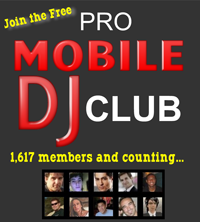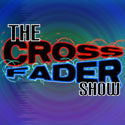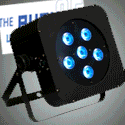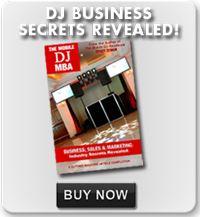By Dave Austin, “Music Professor”
 So you’re a new DJ standing behind the mixer at your first major event. If you’re like I was, you have a vision of packing the dance floor from the very first song and driving the crowd into a dancing frenzy with your music selections.
So you’re a new DJ standing behind the mixer at your first major event. If you’re like I was, you have a vision of packing the dance floor from the very first song and driving the crowd into a dancing frenzy with your music selections.
Now fast-forward to the end of the event. Did your vision become a reality? Probably not, so like me, you’ll have to realize the hard truth.
It’s good to give thought to the music you’re going to plan at an event, and how that music will translate into getting people to dance. Unfortunately, this is the point at which some DJ’s expectations and reality sometimes part ways.
A Moment in Time
We’ve all seen videos of a DJ with a dance floor packed with partying people jumping to the thump of a great song, and naturally, that’s exactly what we want at our gig. However, what the video does not show us is at what point in the event the scene was recorded. And it’s a good bet that the dance floor did not look like that non-stop from the beginning to the end of the event
In practice, don’t expect to fill your dance floor right off. It’s great if you do, and it does happen on rare occasions, but it usually isn’t going to.
Consider the “Settled In” Factor
It’s a critical mistake to play all your best songs right away trying to get people to dance. The truth is, people usually only get around to dancing after they’ve been at the event for a while and/or after they’ve had a few drinks and “settled in.”
It’s not at all uncommon to spend a portion of your event with a near-empty dance floor, but don’t get discouraged. The dancing will happen. Put yourself in the guests’ place and consider how you would feel in an unfamiliar venue and when you would give in to the urge to dance.
Go with Human Nature
As one veteran DJ observed, “People are individuals, but a crowd is a collective.” Human nature being what it is, people are likely to first have some food, some drinks, visit and mill about before feeling comfortable enough to move on to the dance floor. However, once some dancers start getting into it and “breaking the ice,” others will follow.
It’s a good idea to intersperse your early-event sets with songs everyone knows. Such songs can be “teasers” to help put the crowd into a dancing mood and urge them onto the floor. So, you’ve got to carry out a delicate balancing act of keeping your music synchronized to the flow of the event.
Reading the Crowd
Being able to “read the crowd” is a key part of any DJ’s job, and as a result of doing that, your music should be adjusted to the mood of a given time in the event. Drop all you big tunes too soon and you’ll be “out of gas” when the dancing really gets underway. Keep the music on the “down low” too long and you’ll lose your audience as people become bored and leave.
Pay close attention to the crowd, especially the ladies. They’re usually less inhibited than men and can jazz the guys up for dancing and dance with each other.
Do you see guests tapping their feet, nodding their heads and giving off relaxed smiles? Are they beginning to gather around the dance floor? These are some clear signs that your crowd is ready to dance. *Carpe diem and drop a solid dance track now!
Patience is a Virtue
Something we DJs must have is patience, and achieving that quality is something that often comes with experience. Having a realistic expectation of the start, ebb, and flow of guests’ dancing can be invaluable in helping you as a professional.
So go ahead and plan your music in advance — just so long as you’re willing to change things up on-the-fly, and not get upset when guests don’t jump up just as soon as open dancing begins..
* Latin, (v.) seize the opportunity.









